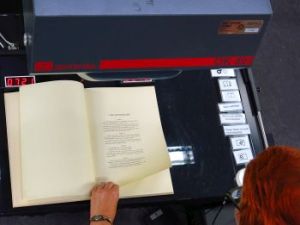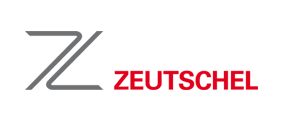October 2016 - Zeutschel cameras microfilm the German Constitution (Basic Law)
Tübingen company provides technology for long-term archiving of the Federal Republic of Germany
 |
The first original edition of the German Constitution and all accompanying documents were stored on microfilm in the National Archives of Berlin using camera technology that was ‘made in Germany’. The Omnia OK 401 from Zeutschel GmbH produces a high image quality. This means that all data is retained for at least 500 years without loss of information and can even be read centuries later with a simple magnifying glass. The roll of microfilm with 30,000 individual images is stored in the Barbarastollen underground archive in Oberried near Freiburg in Southern Germany. This is where the Federal Republic of Germany archives historical documents, which are to be protected from destruction by wars and natural disasters. |
"Preserving valuable cultural property is one of Zeutschel’s key tasks – and has been for 55 years. In consequence, we assist archives and libraries with high-capacity analog and digital solutions. More than 60% of the documents stored in the Barbarastollen underground archive were microfilmed using Zeutschel cameras”, explains Jörg Vogler, CEO of Zeutschel, the only company worldwide to still produce microfilm cameras at the Tübingen-Hirschau site.
Tübingen, October 2016 – Protecting the German Constitution on microfilm was carried out in line with the so-called safeguarding of documentation and microfilming, which is based on the ‘Hague Convention for the Protection of Cultural Property in the Event of Armed Conflict’. More than 100 states have already committed themselves to preserving cultural and archive heritage during peacetime for the generations to come.
Long-term archiving for posterity
The Federal Republic of Germany is therefore safeguarding valuable documents with a high level of national or historico-cultural significance in the Barbarastollen underground archive. This includes the coronation certificate of Otto the Great from the year 936, the contract text of the Peace of Westphalia from 1648, manuscripts of the composer Johann Sebastian Bach and now the German Constitution.
The images on the microfilm recount the history of the German Constitution with original documents such as papers, charters and written communications – totaling 2.6 meter (approx. 6.5 feet) of files. Transcripts of discussions and debates of the Parliamentary Council, the Federal States and the Allied Forces also number among these. The documents show their respective influence on the result of the adopted Constitution.
According to the Federal Office for Civil Protection and Disaster Relief, which operates the Barbarastollen underground archive, the Constitution is the billionth copy of a historical document. All microfilms are stored approximately 400 meter (approx. 1,300 feet) deep inside the mountain in what now amounts to 1,500 stainless steel drums.
Long-term storage of digital data
Zeutschel has been a pioneer and technological trendsetter in microfilm technology since the company was founded in 1961. A complete portfolio of microfilm cameras and microfilm scanners bears witness to this. In addition to the long-term archiving of analog documents, Zeutschel handles long-term protection of the digital data, too. The Archive Writers from the OP series (OP600/OP 700 HR) record top-quality digital images and documents onto microfilm, even as a color exposure.
